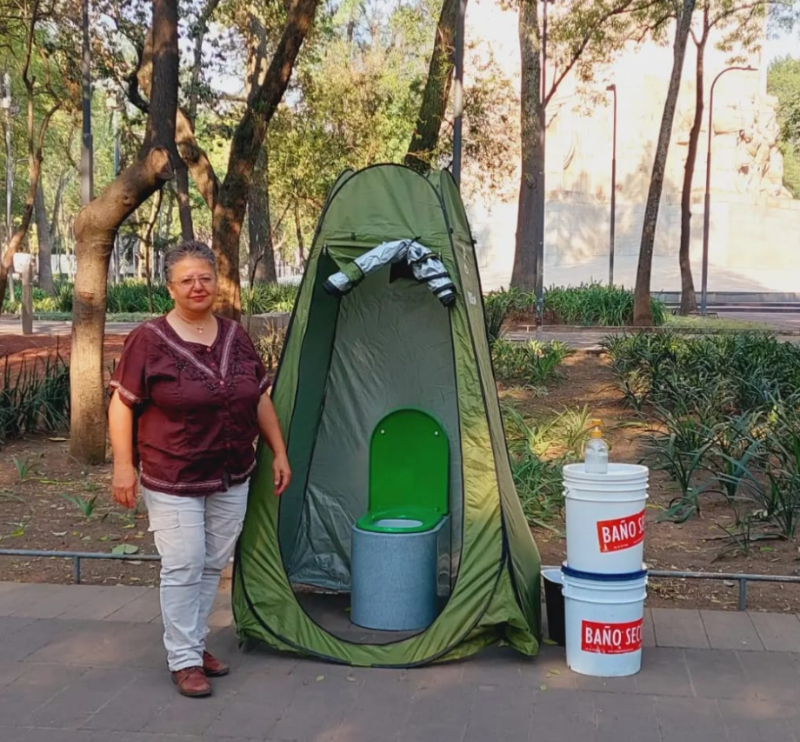- Markets, finance and governance
- Global and regional political processes
- Sustainable Development Goals (SDGs), JMP monitoring
- New : The Sanitation Circular Economy — Rhetoric vs. Reality
New : The Sanitation Circular Economy — Rhetoric vs. Reality
2697 views
- aerosan
-
Less
- Posts: 1
- Likes received: 0
Re: New : The Sanitation Circular Economy — Rhetoric vs. Reality
Attachments:
-
 Aerosan_graphic.png
(Filesize: 197KB)
Aerosan_graphic.png
(Filesize: 197KB)
Please Log in to join the conversation.
You need to login to reply- lourdesv
-

- Moderator
- Arquitecta, trabajando en temas de agua, saneamiento y medio ambiente desde el año 2003, creo en estrategias de educación ambiental y cambio de comportamiento. En mi día a día trato de dejar un mundo mejor al prójimo.
Less- Posts: 34
- Likes received: 13
Re: New : The Sanitation Circular Economy — Rhetoric vs. Reality
The Circular Sanitation Economy in Latin America and the Caribbean (LAC) focuses on transforming the traditional linear sanitation model into a circular one, where waste is considered a valuable resource rather than a problem. This approach aims to create sustainable, efficient, and innovative sanitation solutions that benefit the environment, economy, and society.Key Points:Resource Recovery: The Circular Sanitation Economy emphasizes the recovery of resources from human waste, such as water, energy, and nutrients. This process involves treating waste to produce biogas, fertilizers, and reclaimed water, which can be used in agriculture, energy production, and other sectors. Visit:
LINK AT
Economic Opportunities: By viewing sanitation as an economic opportunity, the Circular Sanitation Economy promotes the creation of new business models and jobs. It encourages investment in technologies and infrastructure that support waste recovery and recycling, fostering economic growth and sustainability. Visit
Link TBC
Environmental Benefits: This model aims to reduce environmental pollution by minimizing waste discharge into water bodies and reducing the carbon footprint. The Circular Sanitation Economy supports sustainable practices that protect natural resources and promote ecological balance.Social Impact: Improving sanitation infrastructure and services enhances public health and quality of life, particularly in underserved communities. The Circular Sanitation Economy seeks to provide affordable and equitable access to sanitation, addressing social inequalities and improving overall well-being.Implementation in LAC:Innovation and Technology: Adoption of advanced technologies for waste treatment and resource recovery is crucial. This includes anaerobic digestion, composting, and wastewater recycling systems tailored to the region's needs.
Picture: Paseo de la Reforma, one of the most important avenues in Mexico City
La Economía Circular del Saneamiento en América Latina y el Caribe (ALC) se centra en transformar el modelo tradicional de saneamiento lineal en uno circular, donde los residuos se consideran un recurso valioso en lugar de un problema. Este enfoque tiene como objetivo crear soluciones de saneamiento sostenibles, eficientes e innovadoras que beneficien al medio ambiente, la economía y la sociedad.Puntos clave:Recuperación de recursos: La Economía Circular del Saneamiento enfatiza la recuperación de recursos a partir de los desechos humanos, como agua, energía y nutrientes. Este proceso implica el tratamiento de los desechos para producir biogás, fertilizantes y agua recuperada, que se puede utilizar en la agricultura, la producción de energía y otros sectores. Visite: ENLACE Aguatuya Oportunidades económicas: Al considerar el saneamiento como una oportunidad económica, la Economía Circular del Saneamiento promueve la creación de nuevos modelos de negocios y empleos. Fomenta la inversión en tecnologías e infraestructura que apoyan la recuperación y el reciclaje de residuos, fomentando el crecimiento económico y la sostenibilidad. Visite el enlace TBC Beneficios ambientales: Este modelo tiene como objetivo reducir la contaminación ambiental al minimizar la descarga de desechos en los cuerpos de agua y reducir la huella de carbono. La Economía Circular del Saneamiento apoya prácticas sostenibles que protegen los recursos naturales y promueven el equilibrio ecológico.Impacto social: Mejorar la infraestructura y los servicios de saneamiento mejora la salud pública y la calidad de vida, en particular en las comunidades desatendidas. La economía circular del saneamiento busca brindar acceso asequible y equitativo al saneamiento, abordando las desigualdades sociales y mejorando el bienestar general.Implementación en ALC:Innovación y tecnología: La adopción de tecnologías avanzadas para el tratamiento de residuos y la recuperación de recursos es crucial. Esto incluye la digestión anaeróbica, el compostaje y los sistemas de reciclaje de aguas residuales adaptados a las necesidades de la región.
Picture: Paseo de la Reforma, one of the most important avenues in Mexico City
La Economía Circular del Saneamiento en América Latina y el Caribe (ALC) se centra en transformar el modelo tradicional de saneamiento lineal en uno circular, donde los residuos se consideran un recurso valioso en lugar de un problema. Este enfoque tiene como objetivo crear soluciones de saneamiento sostenibles, eficientes e innovadoras que beneficien al medio ambiente, la economía y la sociedad.Puntos clave:Recuperación de recursos: La Economía Circular del Saneamiento enfatiza la recuperación de recursos a partir de los desechos humanos, como agua, energía y nutrientes. Este proceso implica el tratamiento de los desechos para producir biogás, fertilizantes y agua recuperada, que se puede utilizar en la agricultura, la producción de energía y otros sectores. Visite: ENLACE Aguatuya Oportunidades económicas: Al considerar el saneamiento como una oportunidad económica, la Economía Circular del Saneamiento promueve la creación de nuevos modelos de negocios y empleos. Fomenta la inversión en tecnologías e infraestructura que apoyan la recuperación y el reciclaje de residuos, fomentando el crecimiento económico y la sostenibilidad. Visite el enlace TBC Beneficios ambientales: Este modelo tiene como objetivo reducir la contaminación ambiental al minimizar la descarga de desechos en los cuerpos de agua y reducir la huella de carbono. La Economía Circular del Saneamiento apoya prácticas sostenibles que protegen los recursos naturales y promueven el equilibrio ecológico.Impacto social: Mejorar la infraestructura y los servicios de saneamiento mejora la salud pública y la calidad de vida, en particular en las comunidades desatendidas. La economía circular del saneamiento busca brindar acceso asequible y equitativo al saneamiento, abordando las desigualdades sociales y mejorando el bienestar general.Implementación en ALC:Innovación y tecnología: La adopción de tecnologías avanzadas para el tratamiento de residuos y la recuperación de recursos es crucial. Esto incluye la digestión anaeróbica, el compostaje y los sistemas de reciclaje de aguas residuales adaptados a las necesidades de la región.
Lourdes Valenzuela
Regional SuSanA Coordinator (Latinoamérica)
Directora de comunicación AGUATUYA
Calle Nicolás Ortiz no. 33 (a media cuadra de la Av. Calampampa)
Tel (591) 4 424 2164
Casilla 6264
Cochabamba – Bolivia
Siguenos:
www.aguatuya.org
www.facebook.com/aguatuya
www.susana.org/en/mailinglist-latinoamerica
Regional SuSanA Coordinator (Latinoamérica)
Directora de comunicación AGUATUYA
Calle Nicolás Ortiz no. 33 (a media cuadra de la Av. Calampampa)
Tel (591) 4 424 2164
Casilla 6264
Cochabamba – Bolivia
Siguenos:
www.aguatuya.org
www.facebook.com/aguatuya
www.susana.org/en/mailinglist-latinoamerica
Attachments:
-
 PIC_1MEX_2...6-10.png
(Filesize: 1,123KB)
PIC_1MEX_2...6-10.png
(Filesize: 1,123KB)
Please Log in to join the conversation.
You need to login to reply- beniland
-
Topic AuthorLess
- Posts: 19
- Likes received: 4
New : The Sanitation Circular Economy — Rhetoric vs. Reality
Sanitation remains one of the most off-track Sustainable Development Goals (SDGs), with 3.4 billion people, about
46% of the world’s population, still without access to safe sanitation facilities
.
Approaches such as Community Led Total Sanitation (CLTS) have helped shift countries towards Open Defection Free (ODF) status. Declarations on achievement of ODF status in countries like India and Nepal in 2019 were momentous and politically strategic, unfortunately multiple studies and assessments show that millions of people in these countries are still defecating in the open.
One promising message that can possibly trigger innovations around the sanitation crisis — is that ‘shit’ is not waste, but instead a basic resource for a trillion-dollar global industry . A circular economy approach of resource recovery and reuse holds the promise of human shit becoming ‘Brown Gold’ through upcycling into energy (biogas production), agricultural (biomass fertiliser) and many more industrial outputs, even (potentially) fuelling shit-powered flight . In addition, huge amounts of water can be recovered from human waste, as faecal matter alone is 75% water, and urine is essentially 95% water . All told, in India alone, the predicted market for waste recovery and re-use is as large as USD$9–28 billion.
While these solutions are potentially promising, questions remain: are these interventions viable, and, more importantly, is this the direction that will solve the sanitation crisis of nearly half the world’s poorest population — who have no safe and sustainable sanitation at all?
Building on evidence from field research in India, Nepal, Ghana and Ethiopia, the Towards Brown Gold project highlights three key issues for urgent consideration in currently popular framings of the sanitation circular economy (SCE).
Authored by Deepa Joshi (IWMI), Lyla Mehta (Institute of Development Studies and Norwegian University of Life Sciences) and Alan Nicol (IWMI)
Approaches such as Community Led Total Sanitation (CLTS) have helped shift countries towards Open Defection Free (ODF) status. Declarations on achievement of ODF status in countries like India and Nepal in 2019 were momentous and politically strategic, unfortunately multiple studies and assessments show that millions of people in these countries are still defecating in the open.
One promising message that can possibly trigger innovations around the sanitation crisis — is that ‘shit’ is not waste, but instead a basic resource for a trillion-dollar global industry . A circular economy approach of resource recovery and reuse holds the promise of human shit becoming ‘Brown Gold’ through upcycling into energy (biogas production), agricultural (biomass fertiliser) and many more industrial outputs, even (potentially) fuelling shit-powered flight . In addition, huge amounts of water can be recovered from human waste, as faecal matter alone is 75% water, and urine is essentially 95% water . All told, in India alone, the predicted market for waste recovery and re-use is as large as USD$9–28 billion.
While these solutions are potentially promising, questions remain: are these interventions viable, and, more importantly, is this the direction that will solve the sanitation crisis of nearly half the world’s poorest population — who have no safe and sustainable sanitation at all?
Building on evidence from field research in India, Nepal, Ghana and Ethiopia, the Towards Brown Gold project highlights three key issues for urgent consideration in currently popular framings of the sanitation circular economy (SCE).
Authored by Deepa Joshi (IWMI), Lyla Mehta (Institute of Development Studies and Norwegian University of Life Sciences) and Alan Nicol (IWMI)
Please Log in to join the conversation.
You need to login to reply
Share this thread:
- Markets, finance and governance
- Global and regional political processes
- Sustainable Development Goals (SDGs), JMP monitoring
- New : The Sanitation Circular Economy — Rhetoric vs. Reality
Recently active users. Who else has been active?
Time to create page: 0.158 seconds







